#development trends in 2020
Explore tagged Tumblr posts
Text
characters don't always need to feel like real people. they just need to get into scenarios
#that episode of criminal about how in recent years crime fiction has trended toward being more about the detective than the mystery#thinking also about the classic films i've been watching that spend barely a moment developing character#and about tenet (2020) and the response to tenet (2020)#in this era of blorboposting sometimes it's nice to center other narrative devices#bri.txt
13 notes
·
View notes
Text
actually to expand on that last post is there truly any more dire state of a genre than western traditional fantasy now.
the top end is dominated by genre tentpoles nobody likes anymore, all of which are stealing the same five ideas (four of them racist) from one another constantly. Amazon blew a billion dollars on a lotr show nobody watched -- WHILE ALSO making a wheel of time show for millions itself and ALSO nobody talks about it. Bioware's probably gonna be dead if DA4 flops; Bethesda might well be dead before even getting a chance to make TES6. DnD is even more of a cultural juggernaut than it ever has been even as everyone hates it more with each passing day. Hasbro needs a billion dollars man. Hasbro needs MONEY. And everywhere else we're stuck in the prequel timeloop of endless nostalgia recursion.
The base of the genre, long dominated by a litany of endless hacks and enthusiastic nobodies has been supplanted by a new generation of neophytes and the 2020s hack, cranking out interminable webnovels emulating anime and light novels or else hopping on new genre trends inspired by anime and light novels like isekai and/or litrpg. There's an entire subgenre that's just " boring Dungeon Keeper letsplays."
The most interesting thing to happen in western fantasy in years is the development of cozy fantasy, the least emotionally challenging genre experiment ever and one which is as creatively bankrupt as it is wildly successful. Just slap a found family sticker and a token queer romance on a small business in a fantasy world and you've got yourself a cozy fantasy. And when those writers truly try branching into fiction when they can't lean on cliche and fanfic formula they write something like rebecca thorn's This Gilded Abyss, a Bioshock rip off so poorly plotted the middle portion of the book becomes literally incoherent.
Genre's fucked man.
470 notes
·
View notes
Text
some alternate things i scripted about the world in my kpop dr
i originally kept my dr the same as my cr. but when i grew out of that my obsession with world building and social science kicked in full force.
now playing...prism / m-flo

the world is futuristic. think love and deepspace esque. we have holograms, high speed travel and advanced energy production. everywhere is equally very developed, but all in a way that suits the culture & environment instead of working against it. the world is modern, beautiful & clean. everywhere is colorful. the world is vibrant, sleek, efficient, full of personality and perfectly balanced.


painting is a highly respected and popular profession since 2020. maximalist, unique, topical and expressive art. with lots of color and varying art styles. artists are able to reach the same levels of success as they couldve in the pre-modern times.
acoris. a spanish brand that sells non alcoholic beverages in various flavors. everyone uses it, its sold everywhere, and has an incomprehensibly large "fanbase". the drink itself gives people a restless high, and insane boosts of energy. though not addictive or classified as a drug (frequently debated).
in person shopping is more popular. high quality, dirt cheap, and somehow ethically sourced trendy clothing are sold in "mall brands". there are thousands of different "mall brands" across the world in every country. they have differing styles per region/brand image reflecting the trends, culture and local materials of the area.



im addicted to my phone and so is the majority of gen z. i want to script phones out entirely, but a modern idols lifestyle is heavy on social media. i settled for ambiguously saying theres little to no technology addiction.
the entire population has a elemental manipulation abilities tied directly to zodiac. for example scorpios have water powers & aries have fire. this has just always been a thing, but for years scientists have been stumped by why. on their own these abilities are weak, but can be stronger with training and teamwork. because of this, humanity as a whole is more connected to nature.
contemplating scripting antartica is fully populated and not frozen. itd be hyper futuristic and very diverse. possibly considered every countries property or something so you can just go in and out? thatd be such a mess but it seems fun.



#shiftblr#shifting blog#anti shifters dni#shifting community#desired reality#shifting realities#shifting motivation#shifting#reality shifting#dr rambles#own gg dr#dr scrapbook#kpop shifting#kpop desired reality
150 notes
·
View notes
Text






💖MAX KYLE 💖| style eras✨[click for hq]
in honour of wifey's 2nd birthday & inspired by @armoricaroyalty's amazing wardrobe analysis series, I thought I'd do a little look back at max from early adulthood until where they currently are in the story. (lena’s style has not changed nearly as much lol) costume design is one of my fav aspects of character development and I put a lot of effort into dressing my sim babies so I wanted to yap about it! (yapping under the cut!)
fresh faced! [2015] - for much of max's adolescence they embrace a pretty standard uniform of graphic tees, skinny jeans + trainers. this doesn't really change for their first year of uni. in their youth they tended to value comfort over style (just autizzy things) but now they're experimenting with colour despite and beginning to emerge from their shell. having two mums means that max's own sexuality isn't a huge deal to them, but navigating the social aspect of it a different story entirely...
alt academic! [2016/17] - having made some friends (hello cleo! - not pictured), max is not immune to the goth-lite trends of the mid tens. they're hitting their stride academically and getting used parties and clubs. this is their first attempt at really exploring their femininity and soon they'll start to wonder if traditional womanhood is truly for them.
soft masc baby! [2017-19] - these years are where the more significant changes in max's style take place. 2017 is a big year for them. just as they begin exploring their gender identity, they meet their first ever girlfriend* (more on that later) and dressing more masc feels safe and exciting! they love how they're able to transform and their gf keeps saying how much hotter they look, but at as time goes on, max struggles with how they see their body under the baggier clothing. they're face with a question 'am I dressing like this for me or because of how others want me to be?'
chaos femme! [2019-20] - having graduated uni and endured their first big break up, max moves to san myshuno eager to reinvent themself. working as strip club bartender they begin dressing femme again, but this time with a sharper, moodier point of view. it's a lot of very high heels, mini skirts and c*nty wigs. almost every pic they post goes viral and they're fast becoming a fixture in san my's queer nightlife scene. this is max's single & chaotic era + this is also when they enter into a short -live but toxic romance with jade. they're working hard, partying harder but of course this lifestyle becomes hard to sustain and it's only a matter of time before it wears max out.
gay casual! [2020-23] - settled in san my, max has moved on from the dollhouse and found a literal home at the 'old salt bar' - an lgbtq hotspot both day and night. they've got a solid group of friends and are truly doing well for what feels like the first time in years. naturally their clothing returns to a brighter colour palette and this is where see them fall into their usual style of cropped tops, baggy trousers and chunky trainers. max's gender expression has more fluidity now and they start experimenting with a more fun, artsy style of make up with brightly dyed hair to match. it's clear now that max tends to mirror the environment they're in and it's clear that they're finally in an environment that feels right for them. unfortunately, they've little idea about the storm heading their way.
flux! [2023-] - this is the max we meet at wifey's beginning. they're in throes of grief but trying to bury it deep. their gender expression remains fluid but their overall style becomes less significant as more pressing matters take hold. this version of max is headed down a darkening path and when out in the world, they're more likely to dress to project confidence and intimidation which to them means a moodier colour palette. only time will tell if they're able to reconcile the innocence of their old self with the truth of their current one...
#misc: wifey#emz: edits#black simblr#simblr#sims community#*max kyle#ts4 lookbook#ts4 edit#tw body dysmorphia mention#tw gender dysphoria mention#tried to give instagram filter on some of the pics u either get it u don't
60 notes
·
View notes
Note
Ayo, someone by the name of Curly-B-Blog is redlining art of yours from 2020 (while pretending that it's actually Sai Scribble's work), and kind of being a dick about it. just thought you should know.
You know, originally I was just gonna brush it off, but then I went back to look at my old SU art from 2020 and did so much self reflection from then till now.
I think this was around the time I was just learning how to do perspective and tried to use the perspective tool on Procreate for the first time? :0 and I remember telling Sai “Sai I have this STUPID idea, I CANT believe it this stupid joke it’s so DUMBBBB, it’s living rent free in my BRAIN I SWEAR THIS IS GONNA BE SO STUPID DCIUWHEFIUWHIRFUIW4F” and being super excited to show her the finished product. People still think Sai created the Cursed Skin Gloves comic and I think it’s hilarious wjhwnuhwijwuiw

The comic was received very well and it made LOTS of people laugh and I’m still proud of this comic to this very day! :D and tbh if it wasn’t for my obsession for Sai’s Switcheroo AU I never would have found my passion in comic work! (love you you stinky hoe @saiscribbles 🩷)
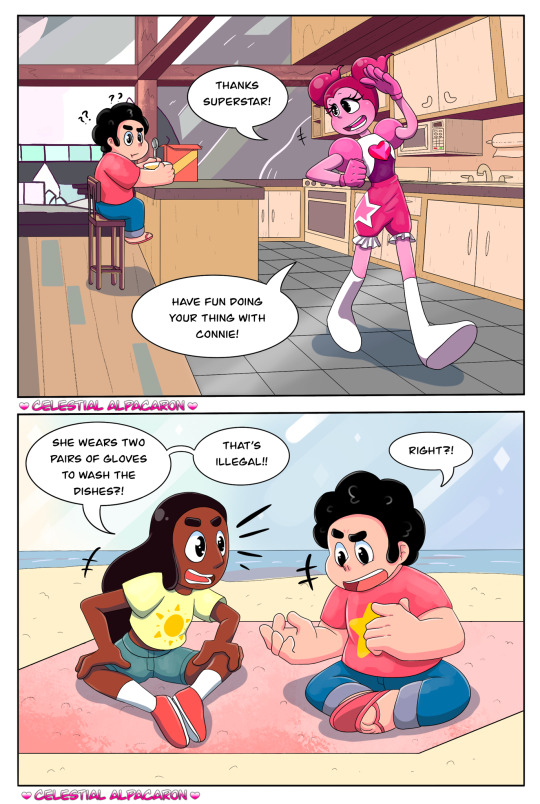
HOWEVER…. I definitely still had lots to learn! I wasn’t very good at perspective at the time I’ll admit, but I was definitely having lots of fun learning :3
And throughout the past 4 years, ALOT has happened.
I graduated from college with TWO fancy pieces of expensive papers in Visual Development in Animation and Illustration learning from Will Kim and Jeff Soto, and as a I was working with the funny voice man Cougar MacDowall as a comic/story artist and reached in total around 7 million views for my fan series FNAF Security Malware Breached (it was even #21 on the trending list around the time of my birthday 🩷 what a lovely gift), had an insane opportunity to work with Mike Geno and with the voice cast from The Amazing Digital Circus for a fan song as a background and character asset artist, Vivienne Medrano liking and sharing my silly Overlord Husk AU comics, currently on my route to getting my certificate from Aaron Blaise’s Character design program and graduating from Marc Brunet Art School, and now I am completing my first year as professional colorist and art assistant for my storyboard and comic mentor Michelle Lam, aka Mewtripled! (Also I’ll be heading out to Lightbox Expo 2024 on October 26 with Michelle and the team so if y’all ever wanna meetup hahahajaj wink wink wink wink wink)
So you can say I learned ALOT and I enjoyed every minute of what I do :D I try to be humble about my accomplishments because blah blah being humble good yes yes but this time I wanna be selfish and say HELL YEAH I DID ALL THIS!!! AND IM SO EXTREMELY PROUD OF MYSELF FIUGEIURGERGGRS
Now here’s my most recent comic page that I posted like 2 days ago without the text.
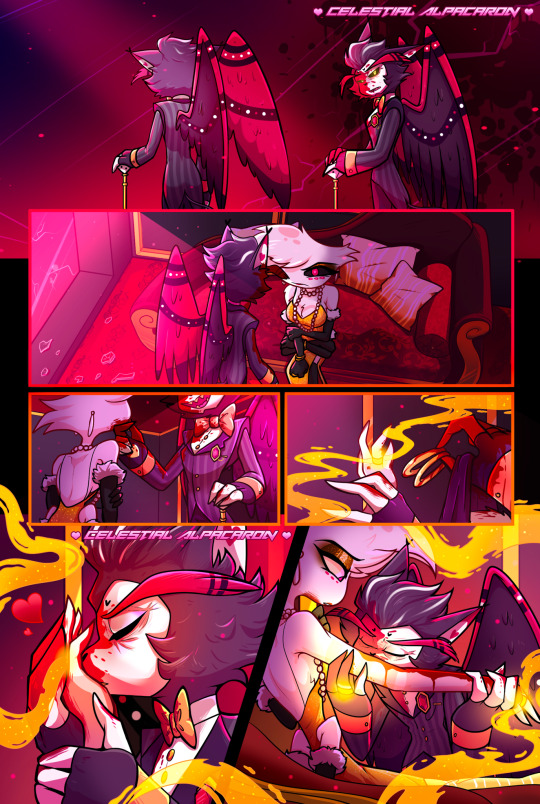
That’s pretty freakin wild to me, I can’t believe I used to draw Steven Universe art like that back in 2020 LOL LIKE GUYS I DREW THIS!! WITH!!! MY HANDS!!! IS THAT NOT INSANE!!!???
Anyways moral of the story:
Learn from everyone and everything! Yes, even then mean ones too! If you can learn to work with anyone, I promise you’ll get to where you want to be faster. People can be a little mean on the internet, but that shouldn’t stop you from being where you want to be in the future. I’m so EXTREMELY grateful for all the opportunities and to all the kind professionals who were willing to give me a chance. Seriously, I’m so graciously thankful for everything, and I hope everyone here will support me and my silly little comics I will do now and in the future!
And one more thing:
Don’t be a jerk. Be to be nice to everyone :D nothing good comes out when you’re bad to everyone.
#celestial’s life lessons#be kind or else 🔪#anyways I gotta go back to work#I also need to draw gay demons kissing byEEEE#ask
325 notes
·
View notes
Text
Rachel Janfaza at Politico:
New data out of Yale’s Youth Poll broke the internet last week when it revealed a partisan split within Gen Z. Given a generic Democrat vs. Republican ballot for 2026, respondents ages 18-21 supported Republicans by nearly 12 points, while those ages 22-29 backed Democrats by about 6 points. It was a stunning gap that undermined the longstanding notion of younger voters always trending more liberal. On the contrary, today’s youngest eligible voters are more conservative than their older counterparts: According to the poll, they are less likely to support transgender athletes participating in sports, less likely to support sending aid to Ukraine and more likely to approve of President Donald Trump. Fifty-one percent of younger Gen Zers view him favorably, compared to 46 percent of older Gen Z. That split might seem surprising, but it’s only the latest example of an emerging dynamic I’ve noticed developing over the last few years: It’s increasingly clear that there are actually two different Gen Z’s, each with a particular political worldview.
Since just after the 2022 midterm elections, I’ve held listening sessions — open-forums for discussion — with teens and young adults across the country to find out how young people think and feel about politics. I’ve traveled to high school and college campuses, community centers and even homes. And as I’ve written before, these conversations with young people illuminated the distinctions between Gen Z 1.0 and Gen Z 2.0.

Gen Z 1.0, the older segment, graduated high school and tasted independence prior to the start of the Covid-19 pandemic. Their coming of age coincided with Trump’s first term in office and the rise of anti-Trump resistance movements for racial justice and gender equity. Social media apps like Instagram and Snapchat, with all their filters and made-for-social media aesthetics, were commonplace — but TikTok wasn’t yet the massively popular platform it is today. Fast forward to 2020 through today, and those in Gen Z 2.0 came of age under different circumstances. They graduated high school during or after the start of the pandemic, which disrupted their K-12 experience. When many in this cohort began college, it was largely on Zoom, or in a campus environment that barely resembled pre-pandemic times. The political situation was also starkly different: With President Joe Biden in office, Trump and his MAGA movement felt like the counterculture — especially for young men, who swung hard to the right.
Indeed, gender played a prominent role in shaping the youth vote in 2024. An analysis by Blue Rose Research found a 20-point gender gap in Democratic support between men and women ages 25 and younger — the largest such gender gap in any generation by far. “It’s normal to see women supporting Democratic candidates at like a five- to 10-point higher rate than men do,” said Ali Mortell, Blue Rose’s research director. “Among the youngest cohort of Gen Z, it’s north of 20 points. So this is really jarring, and I think, caught the Democratic Party somewhat flat-footed.”
That gender gap has attracted a lot of media attention, but the headlines gloss over some important nuances. While young men turbo-charged Trump’s success in November, they’re not the only Gen Zers shifting right. Despite the overall gender gap, the Yale poll found that, while women ages 22-29 have a net-negative favorability of Trump, those ages 18-21 are more supportive of him, roughly split between a favorable and unfavorable view of the president. Young white women in particular are trending more conservative. Data from Tufts University’s Center for Information & Research on Civic Learning and Engagement (CIRCLE) shows that, while women of color ages 18-29 overwhelmingly supported former Vice President Kamala Harris, young white women were split between Harris and Trump, 49 percent to 49 percent. That’s a huge jump from 2020, when, according to CIRCLE’s data, young white women voted for President Joe Biden over Trump by a 15-point margin.
That could be in part because some of the most formative experiences separating Gen Z 1.0 and 2.0 cut across gender — the most obvious being the pandemic. “We’ve definitely been cognizant that there feels like there’s a change between the kids who got through high school before and after Covid,” said Jack Dozier, the 19-year-old deputy director of the Yale survey. “There is a huge variation that came up between just the college-age young adults, and then the young adults who are over 22.”
In my own research, I started to hear about Covid’s impact in conversations with young Americans in 2022. Throughout history, young people haven’t liked being told what to do, and for many younger Gen Zers, the pandemic restrictions chafed against their youthful discomfort with authority. At first, they expressed annoyance with what they saw as prolonged social distancing on campuses that impacted the student experience. As one 20-year-old told me in a listening session at the end of March: “The adults don’t have it all together, and they don’t have my back.” When students finally went back to school, they complained about the policing of their behavior — not just regarding Covid protections like social distancing and masking, but also broader issues around language. Our national online discourse, these young people said, had adopted an overt political correctness and cancel culture – the tendency, particularly in online spaces, to denounce others for controversial statements or action. Many young people perceived this as promoted by Democrats — those in control, not just in D.C., but in pop-culture and on social media.
[...] “Young people are not only consuming digital media content, non-traditional sources at much higher rates than older generations, but they’re increasingly getting their news from non-political, non-traditional sources,” Mortell told me. But she took it one step farther: “We are seeing this very clear relationship between defection away from the Democratic Party and TikTok consumption.” The rapid onset of TikTok encapsulates the head-spinning pace of change younger Gen Zers have experienced. There are cleavages within every generation, but perhaps none more so than Gen Z, which has grown up amid the fastest speed of technological and political change in recent memory. When it comes to their politics, time will tell if the rightward shift sticks. Until then, anyone trying to understand this generation’s politics will need to figure out just which Gen Z they’re asking about.
The Yale Youth Poll confirms that there are two Gen Z’s, with the older Gen Z cohort tracking more liberal, and the younger Gen Z cohort, especially young Gen Z men, trending conservative.
We’ll see how this will hold up in a few years.
49 notes
·
View notes
Text
"Despite the assumption that the younger a person is, the more open-minded their beliefs about sex and gender, the evidence doesn’t stack up. Recent research into younger men’s attitudes towards women and feminism indicate there is no natural evolution away from misogyny and entitlement. A 2016 National Institutes of Health study in which male biology students consistently underestimated the intelligence of their female peers, a 2014 Harris poll showing younger men to be ‘less open to accepting women as leaders than older men were’, and a 2013 Pew survey in which Millennial men are the group most likely to say ‘all necessary changes have been made’ to achieve gender parity (while their female peers are the least). This trend is not confined to the US, or Millennials. Research in 2020 by the UK Hope Not Hate charitable trust showed half of Generation Z men agreeing with the statement ‘feminism has gone too far and made it harder for men to succeed’. The 2020 UN Human Development report, ‘Tackling Social Norms’, showed ‘bias against gender equality increasing in some countries’, with some surveys showing ‘that younger men may be even less committed to equality than their elders’. ‘Painting all young people as battling for “social justice”,’ writes Duffy, ‘misses the fact that less “progressive” values persist in significant minorities of them.’
My own view is that this distorted narrative benefits younger men who are not openly anti-feminist in addition to those who are. Rather than work to offer new, genuinely progressive models of male behaviour, the former can sit back and rely on the presumption that their youth automatically makes them better than their fathers, not to mention their uneducated, gender-ignorant mothers."
Hags by Victoria Smith
123 notes
·
View notes
Text
ateez discography stats?? (preview lmfao)
(freak in the spreadsheets that's what)


work has been chill lately so I've taken to developing an excessively large and detailed spreadsheet that analyzes ateez's discography and line distribution from debut until present... will be posting my full summary soon because as a STEM and spreadsheet nerd I think this is super fun and interesting LOL (if you hate math get off my page (just kidding pls stay))
yes I went through ateez's entire fucking discography to record their total line time for this, shout out to the four line distribution channels I ripped shit from (HEXA6ON, random_k, k_line distribution and others doing the most for this fandom)
my favourite finding so far:

this is a trend most kpop fans know about but I'm showing graphically here. we see a lot of groups start out with line distributions that rely on one or two vocal powerhouses to carry the rest of the group (debate all you fucking want about this, I'm not getting involved in that shit I'm just saying it as it is); then the distribution becomes more "fair" as time goes on and members all get more experience.
in the graph above, there's a lot of variance in 2018, but all the lines have converged recently, indicating a more equal line distribution. the distribution was most equal in 2023 and we've diverged a little bit since then, but 2024 isn't over yet!
some other nerd shit:
hongjoong starts the most songs out of all the members, with 17 songs in which he sang the first line. he's closely followed by yunho, seonghwa, and then san.
yeosang's share of lines has increased by a net 76% since debut, while jongho's has decreased by a net 77%.
13.7% of ateez's total songs are remixes and 12.3% are a Japanese/Korean/English version of an existing song.
on average, ateez songs run for 3 minutes and 12 seconds
whenever a future song is teased in a previous song, we typically wait 3 months for the full song to be released... with the exception of "Sector 1," which was teased in "Outro: Long Journey" back in January of 2020, and wasn't released in full until almost 3 years later.


and a peak at the spreadsheet madness behind all this:

will be posting the rest soon, stay tuned ✌🏻
#ateez#seonghwa#hongjoong#yunho#yeosang#san#mingi#wooyoung#jongho#i dont know what to fucking tag this#using math for brainrot#i fucking love excel thats what#where would the world be without excel guys#im a fake this was actually done on google sheets#excel main bitch sheets is the other woman#fei.txt
99 notes
·
View notes
Text
Also preserved in our archive
Not covid, but another great reason to keep masks on hand: Fine particulate matter increases all sorts of other health issues like asthma, high blood pressure, some cancers, and even strokes. Pollution is just as bad for you as covid in some senses.
By Alden Woods and Kiyomi Taguchi
As Baby Boomers hit retirement, about 1 in 6 Americans is now over the age of 65. The number of Americans living with dementia is projected to skyrocket — but the proportion of older Americans who develop dementia has actually decreased. The exact reason why is uncertain, but various lifestyle and environmental factors can influence a person’s risk of cognitive decline.
One recently discovered risk is air pollution. Studies have linked exposure to a type of air pollution called fine particulate matter, or PM2.5, with an increased risk of developing dementia, and researchers suspect that some sources of PM2.5 may pose a greater risk than others.
New research led by the University of Washington found that wildfire smoke is especially hazardous. An analysis of the health care records of 1.2 million Southern California residents found that higher long-term smoke exposure was associated with a significant increase in the odds that a person would be diagnosed with dementia.
The researchers presented their findings at the Alzheimer’s Association International Conference in July and published the full study Nov. 25 in JAMA Neurology.
“There have been studies that have found total PM2.5 is related to people developing dementia, but no one had looked specifically at wildfire PM2.5,” said lead author Joan Casey, a UW associate professor of environmental & occupational health sciences. “Wildfire smoke is a different animal, in that it’s much spikier. There are many days where there’s no wildfire smoke, and there are some days where exposure is really, really extreme.”
Researchers analyzed the health records of 1.2 million members aged 60 and older of Kaiser Permanente Southern California between 2008 and 2019, all of whom were free from dementia at the start of the study period. They estimated each person’s long-term exposure to both wildfire and non-wildfire PM2.5 as a three-year rolling average, and then identified people who received a dementia diagnosis.
Researchers found that for every 1 microgram per cubic meter (µg/m3) increase in three-year average wildfire PM2.5 concentration, the odds of a dementia diagnosis increased by 18%. Exposure to non-wildfire PM2.5 also increased a person’s risk of dementia, but to a much lesser degree.
“One microgram per meter cubed might sound fairly small, but we have to think about how people are exposed to wildfire smoke,” Casey said. “Most days they aren’t exposed at all, so this might represent a few days of exposure at a concentration of something like 300 µg/m3, where the AQI is over 200 in someone’s community. When you think about it, it’s actually a few really severe wildfire smoke days that might translate into increased risk.”
That risk further increased among racialized people and those living in high-poverty census tracts, following long-term trends in which vulnerable populations often experience disproportionate effects of environmental hazards. The authors suggested that disparities might be related to lower-quality housing, which can increase the amount of smoke that enters people’s homes, or lower-income families’ inability to afford air filtration systems.
The study period does not include the summers of 2020 and 2021, which produced the most extreme wildfire seasons recorded in California. The climate crisis has drastically increased the frequency and severity of wildfires across the American West, introducing “smoke season” in many West Coast regions The influx of smoke has chipped away at air quality improvements made over the last century.
“The main culprit here is climate change,” Casey said. “It’s a global problem. While individuals can protect themselves with air filters and masks, we need a global solution to climate change. It’s going to have to be many-pronged — many people have to be involved to solve this highly complex problem.”
Co-authors on this study are Holly Elser of the University of Pennsylvania; Timothy Frankland of the Kaiser Permanente Hawaii Center for Integrated Health Research; Chen Chen and Tarik Benmarhnia of the Scripps Institution of Oceanography at UC San Diego; Sara Tartof and Gina Lee of Kaiser Permanente Southern California; Elizabeth Rose Mayeda of UCLA; Dr. Alexander Northrop of Columbia University; and Jacqueline Torres of UC San Francisco. This research was funded by the National Institute on Aging and the National Institute for Environmental Health Sciences.
Study link: jamanetwork.com/journals/jamaneurology/article-abstract/2827124
#clean air#air quality#respiratory health#mask up#public health#wear a mask#wear a respirator#masking#masks#masks work
71 notes
·
View notes
Text
🖖 Why? The Tragedies of Star Trek
Storytelling or Strategy?
If you're a Star Trek fan, you've probably asked yourself the same question I have, more than once: Why?
Why did they kill Captain Kirk?
Why did they kill Mr. Spock?
Why was Vulcan blown up?
Why was Praxis destroyed?
Why was Romulus erased from the universe?
These aren’t just dramatic plot twists. They’re galactic gut punches, tearing away at what makes Star Trek home. So, what gives? Is it all just shock value—or is there something deeper going on?
💔 The Death of Captain Kirk (Star Trek: Generations, 1994)
Kirk’s death was marketed as a “passing of the torch” from the TOS crew to The Next Generation.
But what fans got was... a lonely fall off a metal bridge.
There was no blaze of glory. No moving tribute. Just a quiet death that felt deeply unearned. Kirk, the embodiment of hope and command. Kirk, the spirit of Star Trek. Kirk deserved more than a corporate sacrifice for "stakes."
✨ “Heroes don't always get epic endings.” 🚫 Yeah, but this one should have.
🖖 The Death of Mr. Spock (Post-Nimoy)
When Leonard Nimoy passed in 2015, the grief was real and profound. So when the films canonized Spock Prime’s death, it felt like the end of an era—but also a door closed too soon.
Spock died off-screen. No illness. No noble sacrifice. Just... a quiet reference.
🖤 It was respectful. But not Star Trek enough.
It wasn’t just Spock who died—it was logic, legacy, and a generational voice. And many fans weren’t ready to let go.
🌋 The Destruction of Vulcan (Star Trek, 2009)
Vulcan is a cornerstone of Federation identity. First Contact! Erased by a single drill and a black hole.
The reason? “To show anything can happen.” To make the reboot edgy. But it came at the cost of history, culture, and depth.
🧠 Young Spock’s trauma became a narrative tool. 💥 But was blowing up Vulcan worth it?
This wasn’t bold. It was brash. Trek’s utopia gave way to chaos.
☢️ Praxis (The Undiscovered Country, 1991)
Here’s one that worked.
Praxis was a metaphor. A Cold War parallel. A warning about environmental carelessness and political denial.
Its destruction meant something: it forced peace talks. It was narrative propulsion, not spectacle.
🖋️ Real-world allegory. Real consequence. This is Trek at its best.
🌌 Romulus (Star Trek 2009 + Star Trek: Picard, 2020)
Romulus was obliterated off-screen to justify Spock Prime and Nero’s backstory. In Picard, it becomes the emotional wound that drives Jean-Luc’s disillusionment.
But again... a legacy world destroyed just to reboot or reshape.
😓 Tragedy used as emotional fuel—again.
📉 Trend or Tradition?
So what’s the real story here? Is all this destruction a creative choice? Or a calculated strategy?
Too often, it feels like:
Studio execs chasing viral moments
Explosions made for trailers
Death as an easy plot device
Tragedy over development
“Clean slates” over meaningful continuity
But Star Trek was never about burning it all down. It’s about loyalty, friendship, hope, connection, legacy, and resilience. That’s what makes it endure.

23 notes
·
View notes
Text
Direct correlation of South Korean fashion and beauty taking over Indian Gen Z consumer trends → urban Indian queer youths developing the ugliest, blandest, most classist, most Tiktok-wise homogenized fashion aesthetic and beauty standards ever seen in South Asian history in the late 2020s
#it's all so lifelessly consumerist and minimalist and devoid of character and color#it looks mass produced in sweatshops (it probably is) and every one of them south kolkata bisexuals DRESSES THE SAME.#it's also fascinating how many books i know in the recent past that talk about the Asian beauty/skincare/fashion industry#as pure horror.#and by asian i mean. specifically east asian beauty standards (especially korean)#i never saw such a spike in ~ visual ~ or ~ clean beauty ~ or ~ minimalist street style ~ as i did in last 4 years
22 notes
·
View notes
Text

Disney TVA Creator Pedro Eboli Reveals Rejected "Adventures Of The Gummi Bears" Reboot As Part Of Rejected Projects Trend On Twitter.
The Disney Afternoon IPs have been returning to our screens since the late 2010's and 2020s with projects like "DuckTales" (2017) on Disney XD, "Chip 'n Dale: Rescue Rangers" as a live-action/animation hybrid film for Disney+ ,"Darkwing Duck" & "TaleSpin" having reports of upcoming animated reboots by Point Grey Pictures & Disney TVA for Disney+ and "Gargoyles" with a live-action reboot with Blumhouse Television and Atomic Monster for Disney+.
The only properties left to reboot from The Disney Afternoon roster are "Adventures of The Gummi Bears", "Goof Troop", "The Mighty Ducks", "Bonkers" and "The Shnookums & Meat Funny Cartoon Show".
Back in February Becky Dreistadt and Frank Gibson ("Star Vs The Forces of Evil", "Big City Greens The Movie: Spacecation", Cartoon Network Studios "Steven Universe Future") revealed that they attemped to pitch a reboot of "Goof Troop" to Disney back in 2019 for Disney+. Their reboot pitch would have been a mixture between the original show and it's two movies ("A Goofy Movie", "An Extremely Goofy Movie").
It seems that Goof Troop wasn't the only Disney Afternoon property with plans to be rebooted as animation industry and current Disney TVA creator Pedro Eboli (Netflix “Cupcake and Dino: General Services”, Cartoon Network LATAM “Oswaldo”, Nickelodeon “Ollie’s Pack” and Discovery Kids LATAM “Bada Bean”, “NDA - Disney Channel Series”) took over Twitter to reveal that he and his partner in crime Mark Satterthwaite (Netflix “Cupcake and Dino: General Services”, Cartoon Network LATAM “Oswaldo”, Nickelodeon “Ollie’s Pack” and Discovery Kids LATAM “Bada Bean”) attemped to bring back The Kingdom of New Gumbria and The Gummi Bear Juice to a new generation of fans on a pitch for a "Adventures of The Gummi Bears" reboot likely for Disney Channel or Disney+. Eboli would mention that a pilot wasn't produced as they only had scripts for it and was very early on development when it was passed also that the artwork you're seeing in this post is not the actual art that was part of the reboot's pitch bible.


Who knows maybe in the future specially with Disney's plans to attract more subscribers to Disney+ and it's desire for bringing back "The Disney Afternoon" to a new generation maybe they will revive Mark Satterthwaite and Pedro Eboli's "Adventures of The Gummi Bears" reboot specially with their overall development deal at Disney TVA for new shows films and specials.
Not hope at all is lost for Pedro Eboli and Mark Satterthwaite as they have been developing a new original animated series for Disney Channel as of Fall 2023 with the pilot being recorded on January 2024, if picked it will be the first Disney TVA series created by a Brazilian.

#Adventures Of The Gummi Bears#The Adventures Of The Gummi Bears#Jymn Magon#Pedro Eboli#Mark Satterthwaite#Disney Afternoon#The Disney Afternoon#Disney Television Animation#Disney TV Animation#DTVA#Disney TVA#Disney TVA Pilots
61 notes
·
View notes
Text
Harry Styles/Louis Tomlinson AO3 Works Stats
The other day, I was curious to see what the trajectory of uploads of Larry fanfic on Ao3 was and if it was increasing.Anyway, it was a pretty simple process, and here were the findings:
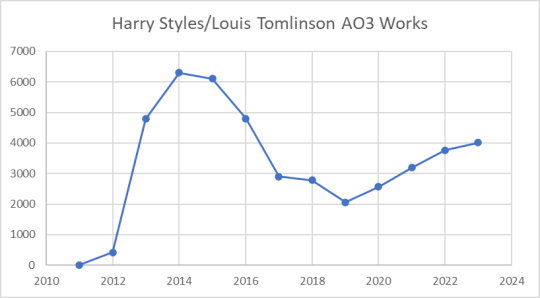
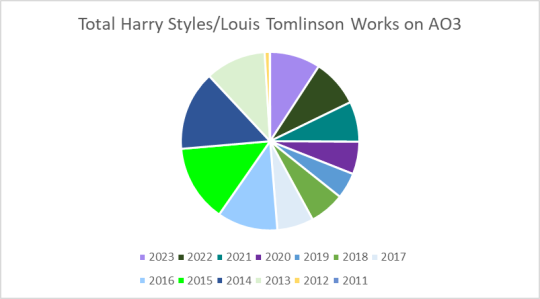
Perfect right? Done. Time to go to bed? No, because ya girl got hyper-fixated. So grab a cup of tea and enjoy this absolutely ridiculous waste of time...
Introduction
The Covid-19 pandemic profoundly affected various aspects of societal behaviour, including participation in online communities. The ‘Larry fan fiction community’ had a notable influx of new participants and emerging writers during this period. My antedotal observations suggested a significant number of authors have been publishing their first works as recently as this month. This study aims to quantify the trends in Harry Styles/Louis Tomlinson fan fiction uploads on AO3 (Archive Of Our Own) over the past decade, with a particular focus on discerning any noticeable uptick in contributions corresponding to the pandemic’s timeline.
Method
The data collection was executed over several days, starting from the 16th of October 2023. Due to this, the 16th of October was used as a reference point for all of the 12-month periods. The following parameters were employed for filtering:
Relationship Category: Harry Styles/Louis Tomlinson.
Inclusivity: All pieces that included this relationship, irrespective of the presence of other pairings. The result of this means there are likely some works included where they are a side pairing.
Language: All languages were included.
Work Status: Both individual pieces and those parts of a series were included, as were completed and incomplete works.
Accessibility: Being logged in allowed access to members-only works.
During the analysis, two works were excluded due to backdating, to ensure the timeframe remained consistent. Due to the dynamic nature of the fan fiction platform, some works underwent updates or were removed during the data collection process. While these fluctuations did cause some inconsistencies, they were negligible and did not significantly impact the overall dataset.
For the 12-month periods under consideration, three main categories were analysed: total, completed, and unfinished.

Results
A comprehensive analysis of Harry Styles/Louis Tomlinson fan fiction uploads spanning from 2011 to 2023 revealed the following insights:
2011: A total of sixteen works were documented, all of which were completed.
2012: The total number of uploads rose to 417. Among these, 409 were completed works, while eight remained unfinished.
2013: A significant surge was observed, with total uploads reaching 4,795. Completed works accounted for 4,251, whereas 544 were left incomplete.
2014: The growth trend continued, recording a total of 6,303 uploads. 5,296 were completed, and 1,007 were in-progress.
2015: The first decline was witnessed, although minor, with 6,105 total uploads. Completed works comprised 4,919, and unfinished ones stood at 1,186.
2016: A slight decline was noted, totalling 4,805 works. Completed pieces were 3,765, with 1,040 still in-progress.
2017: Uploads further decreased to 2,898. Of these, 2,297 were completed, and 601 remained unfinished.
2018: A modest rise was seen with 2,784 total works. Completed contributions were 2,275, while 509 were ongoing.
2019: The total dropped to 2,064. Completed pieces stood at 1,700, and 364 were still under development.
2020: A slight increment occurred, totalling 2,572 uploads. Of these, 2,071 were finished, and 501 were ongoing.
2021: The count increased to 3,195. Completed works reached 2,483, with 712 in-progress.
2022: A total of 3,767 works were uploaded. Completed works were 3,090, while 677 were yet to be finished.
2023: The most recent data showcases 4,018 total works, with 3,104 completed and 914 still ongoing.
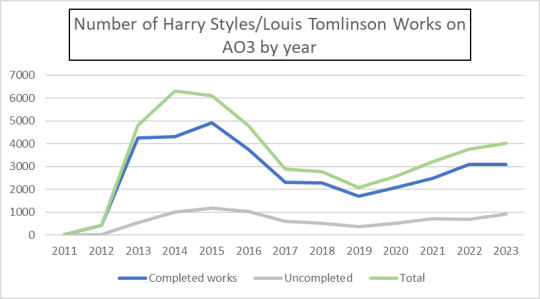
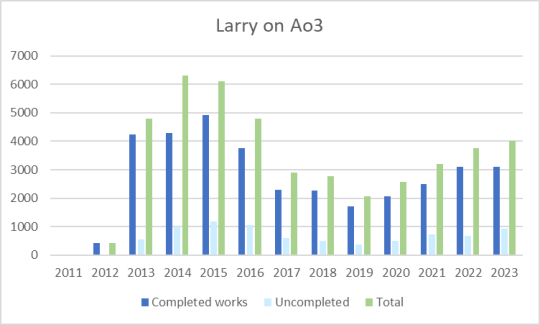
After collating the primary data on completed and uncompleted works, I wanted to look at the distribution based on word count. The intention behind this exploration was to discern if there were patterns or preferences within the writing community regarding the length of the stories. (Please note that on diagrams representing word count, the years are now in descending order)

The categorisation of word count was structured. Works were segmented into word count brackets that started from the shortest stories, ranging from 0 to 1999 words, then progressively moved up in intervals: 2000-4999 words, 5000-9999 words, and so on due to the high prevalence in numbers in the shorter works. This structured approach allowed for a visual representation of how numerous works fell into each bracket for each year.

If you click on it, you might be able to see the distribution.
Results: Word Count Analysis
The following overview encapsulates the distribution of word counts for fan fiction uploads from 2011 to 2023:
0-10,000 Words:
2023 observed the highest concentration within this frame with 2507 works. Over half of the total published works for the 12-month period were found within this bracket.
The trend experienced notable growth from the 14 entries in 2012.
2014 saw a peak with 4994 works in this category, followed by a fluctuating pattern in subsequent years.

10,001-50,000 Words:
2023 recorded 1,031, a slight increase from 1,010 in 2022.
2015 led the chart with the most works in this range.
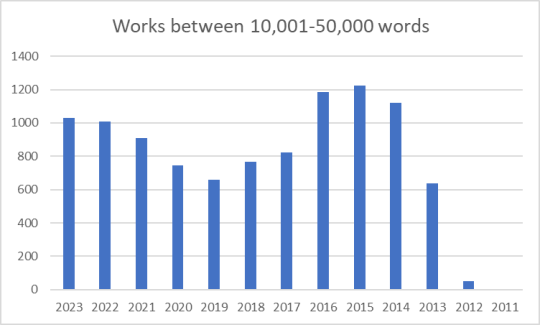
50,001-100,000 Words:
The count in 2023 showcased the highest number in this category, with 293 works.
2016 and 2021 were equal second, with 219 works in this category.

100,001-300,000 Words:
2023 had the most works in this segment, followed by 2022 and 2021.
Prior to this, the peak was in 2017.
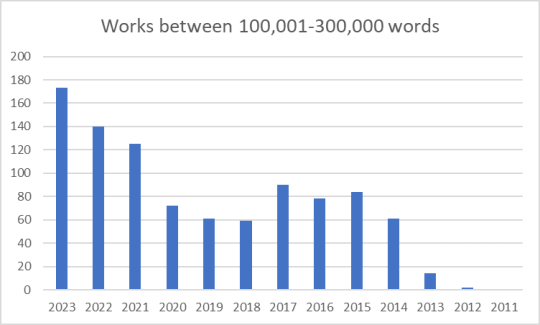
300,001 Words and above:
The numbers in this range are comparatively limited, with 2023 having the most works surpassing 300,000 words.
Most years witnessed very few works in this extensive word count bracket, with numbers often remaining in single or low double digits.


I was also interested to find where most work stopped being completed. This is the percentage of completed works in each range.
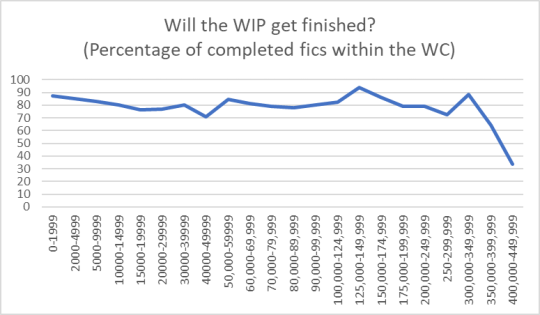
Limitations of the Analysis:
AO3 Filtering System Limitations: The AO3 filtering system does not readily display the initial posting date of a fic. A fic could have been started several years prior to its completion but only shows up in the filtering system in the year it was last updated. This poses a significant limitation as the actual duration taken for the completion of a work might not be accurately represented.
Human Fallacy: There's always a potential for human error in manual data collection and analysis. Overlooked details, misinterpretations, or unintended biases can inadvertently influence the results.
Deletion and Date Modification of Works: Authors may delete their works or modify posting dates. This becomes significant for older works with a higher likelihood of deletions or date changes. Such actions can skew the numbers, offering a misrepresented view of the works available during a particular year.
Variability in Word Count Reporting: While categorising based on word count is useful, it's possible that authors might update or expand their works after the initial posting, leading to changes in word count categories over time.
Conclusion:
The data spanning from 2011 to 2023 shows that over the 13-year period, there has been a marked increase in both completed and uncompleted works, with the total number of works increasing more than 250-fold from 16 in 2011 to 4018 in 2023.
From 2011 to 2015, there was a notable surge in the number of completed works, culminating in 2014 with a total of 6307 works. This could potentially reflect an increased growing interest or a pivotal shift in the community or broader fandom dynamics during this period.
From 2016 to 2019, a noticeable decrease in the total works emerged, with 2019 seeing the steepest drop. This decline aligns with the onset of One Direction's hiatus. While causation cannot be conclusively established, it does provide a reasonable explanation.
Beginning in 2020, a revitalisation is evident, with figures steadily climbing and nearing their zenith by 2023. While this remains speculative, anecdotal accounts suggest that the pandemic, affording individuals more leisure for social media coupled with the growing popularity of TikTok, may have reignited interest in the fandom, steering them towards both reading and potentially writing fanfiction.
In summary, the AO3 community showcases dynamic growth, decline, and resurgence patterns over the examined period. While completed works have seen fluctuating trends, the spirit of initiation remains unwavering, as observed by the consistent number of uncompleted works.

Length of works
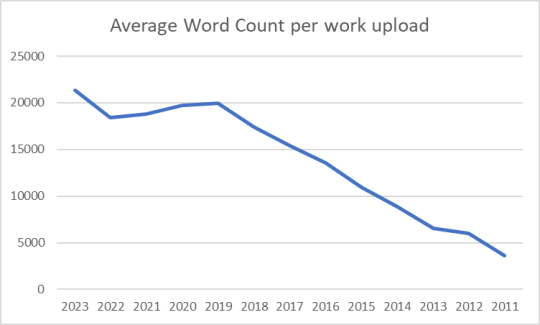
In 2011, the publication of longer stories (10,000 words and above) was almost non-existent. The numbers began to rise steadily, with a significant jump in longer stories from 2015 to 2017.

The number of stories with a word count between 10,000-14,999 went from 2 in 2011 to a peak of 458 in 2014. Similarly, the 15,000-19,999 range saw an increase from 0 stories in 2011 to its peak at 253 in 2015. As we progress through the word count brackets, there's a discernible growth trend, albeit with some fluctuations. For instance, the 80,000-89,999 bracket jumped from 0 stories in 2011 to a peak of 48 stories in 2023.

While there have been fluctuations in the numbers for some years, the overall trend does show growth in the publication of longer stories over the past decade.
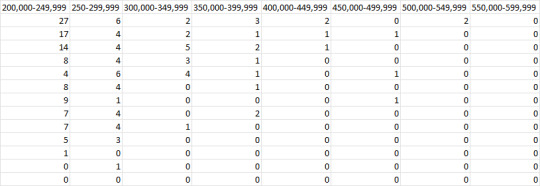
The data shows that extremely long stories (those above 200,000 words) have always been a rarity. However, there's still a perceptible trend.
The 200,000-249,999 word count range sees the most action, with a peak of 27 stories in 2023. This is growth from the previous years 17, and then to 14, and so on. The numbers decrease as we progress to the right into the higher word counts, but occasional stories reach these impressive lengths.
The 250,000-299,999 word count range has peaked at 6, with numbers generally dropping with previous years. Higher word count ranges, such as 300,000-349,999 and 350,000-399,999, are sparser but maintain a presence.
Word counts of 450,000 and beyond are sparse, with very few recent entries.
In conclusion, while very lengthy stories remain uncommon, they exist and have seen publication in varying numbers. There's a trend towards fewer stories as the word count increases, which is expected given the monumental length of these works.
Upon examination of the data, there's a pronounced resurgence in the publication of longer narratives, particularly following a noticeable decline post-2016. The trajectory of this resurgence hints at an evolving literary landscape, with authors and perhaps readers veering towards more extensive works. Although the factors underpinning this shift remain speculative, the upward trend, especially in the realm of extended narratives, cannot be dismissed.
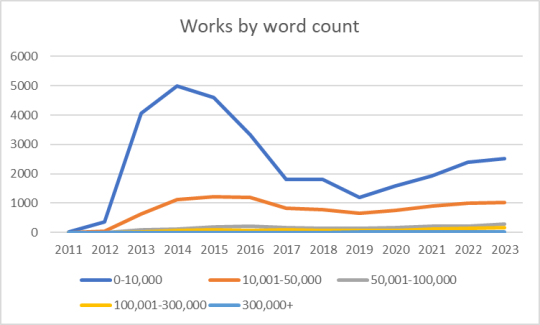
Monitoring developments in this sphere to ascertain whether this resurgence signifies a phase or a deeper, more sustained transformation in literary predilections will be interesting.
#hlcreators#hlsource#larry stylinson#Why am I like this?#harry styles#louis tomlinson#ao3 fanfic#ao3 harry styles/louis tomilson#ao3 larry
180 notes
·
View notes
Text
So I’ve had some Thoughts about Witch Hat Atelier
I mentioned recently, rather kind of casually, the difference in the reading experiences between things like infinite scroll comics and paged comics, and I really wanted to talk more about this. I personally really enjoyed Understanding Comics: The Invisible Art by Scott McCloud, and part of that was the time he took to explain what the gutters and empty space do for comics.
And while I don't feel super comfortable talking about webcomics and their large white space because a lot of webcomics are manhwa and manhua. I don't know enough about Korean and Chinese comic publishing to say much on how those trends developed. Especially at the current time because I don't like them that much, and often I feel they add too much time between panels. It is probably better that these are scrolling comics because if I did have to do the physical act of having to move a page instead of flicking my thumb, I would be so much more annoyed. Now something I try to think about when reading comics is why something is a comic, and I realized some of my issues with these types of manhwa and manhuas are because they start life as light novels. And that is putting us in the realm of adaptation, where the the mediums differ and don't always make it.
In that train of thought, I remembered one of my current favorite mangas, Witch Hat Atelier. Witch Hat Atelier is a manga, and I'd argue to a certain extent it knows it's a manga, and it loves what it is. Shirahama Kamome's detailed art conveys a deep level of love for her craft. Not just of drawing but of the art of manga. In volume 9 of Witch Hat Atelier on pages 30 and 31, the cast arrives in a city getting ready for a festival. It starts with the standard establishing shots, but then you see the cast looking out excitedly and poking out of their panel. They are looking at the next page, which is this scene of the town and its people excitedly getting ready for the festival. It uses its panels on that page like a window the characters are using to look out onto the large scene. And at the corner, it looked like the page was being turned; you could even see the hint of a speech bubble on the next page.
TikTok user Sir Supervillian/Sir Superhero did a series called "Into the Mangaverse," where he randomly read the first volume of a manga. One of these was the first volume of Witch Hat, in which he said:
"This story could be adapted into pretty much any other medium—Western comics, novels, or whatever—with no real change. And that speaks to the strength of the narrative."
While I agree Witch Hat Atelier's writing is incredibly strong, I don't think it truly could be in any other format without losing part of its depth. It is a story where magic is cast by drawing, and it itself is told in a medium where it is being drawn. The introduction to chapter one is a two-page spread of Coco at the lake, but it's in a book and still in the process of being drawn; a hand holding a pen is there drawing and coloring the scene. That is the core of what Witch Hat Atelier is.
On top of that, Shirahama's panels in general are done with a lot of care and artistry. Some panels have fancy boards or bigger scenes that are broken up by panels or by gutters. It's used most effectively when Shirahama is telling the lore of the world, going the extra mile to show that this is a story in the story and this is a history of this world. Yes, some of this could translate to an anime, but we still would lose that magnificent paneling. I am not even convinced this could be translated to a western comic. Partly because of the size, color, and Witch Hat Atelier's paneling, it feels simply too dynamic to fit within a western standard. The art is too detailed. I find it hard to change anything of Witch Hat Atelier without it losing something that makes it a special and beautiful thing to read. Hell, it did win an Eisner Award in 2020 for its English release.
Yes, Witch Hat Atelier is an amazing piece of fiction, but it's a piece of fiction that is at its best in its original form, a manga.
#witch hat atelier#comics#I gen believe if more people need to read#both#Understanding Comics#and witch hat because they talk about comics as the art they are#the combination of writing and drawing#also yes I want that anime SO Bad but i don't thing the current industry can give us what we deserve.#I would love to be wrong tho
17 notes
·
View notes
Text
Dylan Scott at Vox:
Measles, mumps, and polio are supposed to be diseases of the past. In the early to mid-20th century, scientists developed vaccines that effectively eliminated the risk of anyone getting sick or dying from illnesses that had killed millions over millennia of human history. Vaccines, alongside sanitized water and antibiotics, have marked the epoch of modern medicine. The US was at the cutting edge of eliminating these diseases, which helped propel life expectancy and economic growth in the postwar era. Montana native Maurice Hilleman, the so-called father of modern vaccines, developed flu shots, hepatitis shots, and the measles, mumps, and rubella (MMR) vaccine in the 1950s and ’60s, which became virtually universally adopted among Americans.
Smallpox, the most common form of which has a 30 percent fatality rate, has been eradicated. Mitch McConnell, Republican titan of the Senate, may be the last major public figure still afflicted by a childhood case of polio, less than a century after it paralyzed a sitting American president. Measles likely infected millions of people annually in the US in the 1800s, although precise estimates from the era are hard to come by. In the early 1990s, thousands of people died from the disease every year. It was still infecting more than half a million and killing hundreds per year on average in the 1950s and ’60s, before the vaccine debuted. Diphtheria, a deadly respiratory infection, killed more than 1,800 people annually between 1936 and 1945 as the vaccine against it was still being rolled out. It has not killed anybody in the United States in decades. The vaccines that made this possible are among the most important achievements in human history. And yet many Americans appear to be losing faith in them, a worrying trend that could accelerate if President-elect Donald Trump succeeds in handing control of the top US health agency into the hands of Robert F. Kennedy Jr., the country’s foremost vaccine denier.
Kennedy has spent much of his public career pushing the thoroughly debunked theory of a link between autism and childhood vaccines. He has supported an anti-vaccine group in Samoa, where measles vaccination rates have since fallen off; a 2019 outbreak killed 83 people just a few months after Kennedy visited the island and met with anti-vaccine advocates. He has likewise cast doubt on the safety and efficacy of the Covid vaccines, a position that helped nudge the lifelong Democrat toward Trump. After Kennedy dropped his own presidential campaign this year, he became Trump’s most influential health adviser and last week was nominated by the president-elect to lead the Department of Health and Human Services (HHS).
[...] As long-accepted, lifesaving public health measures increasingly become politically polarized, routine vaccination rates are rapidly declining in much of the US. In the 2019–2020 school year, three states had less than 90 percent of K–12 students vaccinated against measles, mumps, and rubella. By the 2023–2024 school year, 14 states had fallen below that threshold. The number of states with more than 95 percent of schoolchildren vaccinated — the preferred level of coverage to prevent outbreaks — dropped from 20 to 11 during that same period.
Smallpox, measles, and polio, which were thought to be eradicated with mass vaccinations, but the anti-vaxxer extremist movement’s rise in influence in recent years threatens to undo decades worth of progress.
30 notes
·
View notes
Text
KNB Headcannons
Kagami-
secretly adores rom-coms: I've seen this once before, but in my mind it's not like common rom-coms. I'm talking, early 2000s, very guessable endings, in his free time.
Cant Cook- despite growing up in the US taiga, can't cook to save his life. That's why he eats out so much. He'd burn water.
Kise-
Language Genius: Now, I say this with limits. But he definitely learned some basic French in like 3 months for a gig. But as soon as he was done, he forgot it all. (He does this a lot.)
Secret black mail pictures: you heard me. This man has whole albums in his phone of pictures to embarrass his friends and teammates. I'm talking hundreds in total.
Midorima-
his phone is organized: remember the trend in 2020 to organize your phone based on color or use. he never quite left that phase. if he gets a new app, it's immediately sorted.
His phone AI has a name: This one made me laugh. Some phones have specific AI (Siri, google), and Shintarou named his. He thinks it's rude to talk to the phone like it's a phone...
Murasakibara-
Flavor king: Everyone knows he loves his food. But because he eats so much, he has developed the ability to taste certain seasonings or ingredients if and when asked.
sensory strips: Atsushi, if not snacking, is often sleeping. So in times when he wants to stay awake, he puts those sensory sticker strips on his phone or just a stray one in his pocket. (That's why he has a hand in his pocket 80% of the time.) It also helps him focus and not zone out.
----------------
first post, yay!
-Tink<3
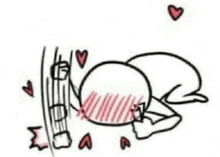
11 notes
·
View notes